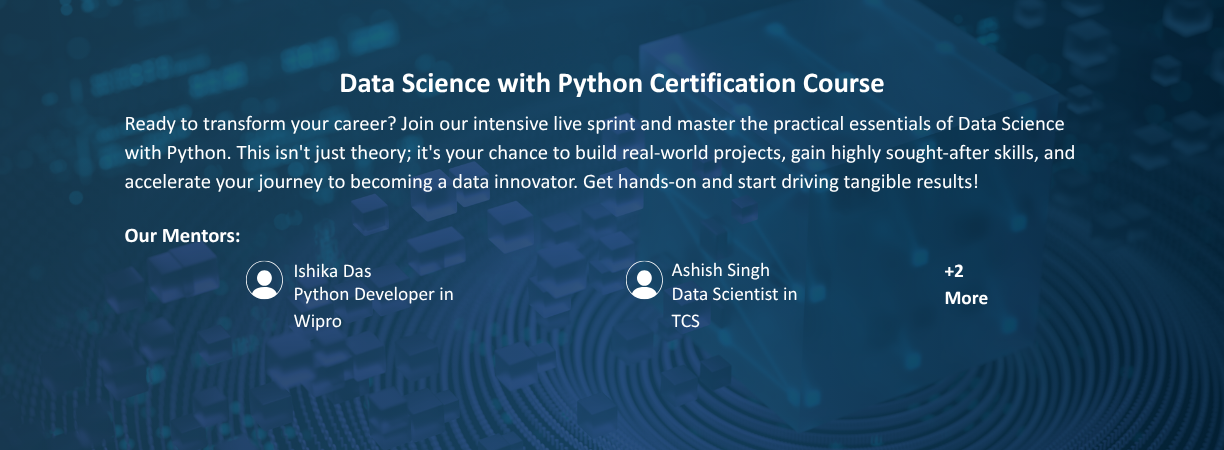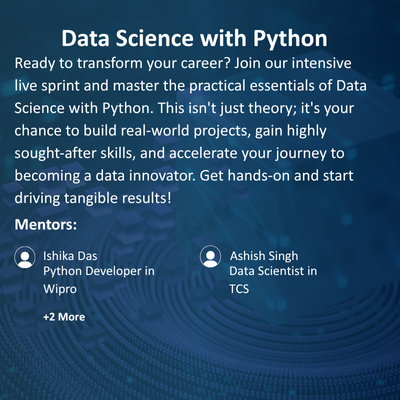



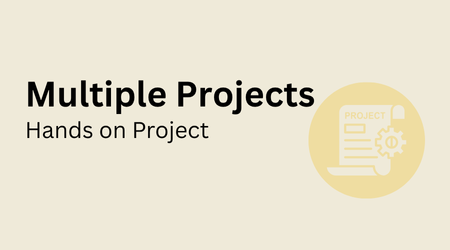



Major Industry Recruiters






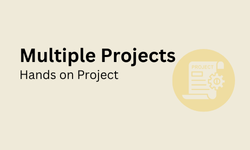

Major Industry Recruiters
Course Description:
The Data Science with Python Training is designed to provide participants with a comprehensive understanding of the key concepts, tools, and techniques used in the field of data science. In this course, you will learn how to analyze and visualize data, build machine learning models, and implement data science workflows using Python, one of the most widely used programming languages in the data science ecosystem. You will gain hands-on experience with popular libraries like Pandas, NumPy, Matplotlib, Scikit-learn, and more, enabling you to tackle real-world data science problems and make data-driven decisions.
Course Objectives:
By the end of this training, participants will be able to:
Understand the core principles of data science, including data exploration, cleaning, visualization, and analysis.
Learn how to use Python for data manipulation, data cleaning, and data transformation using libraries like Pandas and NumPy.
Gain expertise in statistical analysis and hypothesis testing.
Build and evaluate machine learning models using Scikit-learn.
Visualize and interpret data using Matplotlib and Seaborn.
Implement data science workflows from data collection to model deployment.
Gain hands-on experience with real-world datasets and projects to apply your learning.
Course Module:
Module 1: Introduction to Data Science and Python
What is Data Science? Overview and applications in various industries.
Introduction to Python for Data Science: Why Python is popular for data science.
Setting up the Python environment (Anaconda, Jupyter Notebooks, and IDEs).
Overview of Python libraries used in data science: Pandas, NumPy, Matplotlib, Scikit-learn, and Seaborn.
Module 2: Python Basics for Data Science
Python data structures: Lists, Tuples, Sets, and Dictionaries.
Control flow: If-else statements, loops, and functions.
Introduction to Python’s object-oriented programming (OOP) concepts.
Working with files and data formats: CSV, JSON, and Excel files.
Module 3: Data Manipulation with Pandas
Introduction to Pandas: Series, DataFrames, and basic operations.
Importing and exporting data using Pandas.
Data cleaning: Handling missing values, duplicate data, and outliers.
Data transformation: Sorting, filtering, and aggregating data.
Merging and joining datasets in Pandas.
Module 4: Data Analysis with NumPy
Introduction to NumPy and its importance in data science.
Working with NumPy arrays and matrix operations.
Mathematical functions and broadcasting in NumPy.
Random sampling and generating random data with NumPy.
Module 5: Data Visualization with Matplotlib and Seaborn
Introduction to data visualization and its importance in data science.
Basic plotting with Matplotlib: Line charts, bar charts, histograms, and scatter plots.
Customizing plots in Matplotlib: Titles, labels, legends, and annotations.
Advanced visualization with Seaborn: Heatmaps, box plots, and pair plots.
Visualizing distributions and relationships in data.
Module 6: Exploratory Data Analysis (EDA)
Understanding the purpose and importance of EDA.
Techniques for summarizing data: Descriptive statistics and correlation analysis.
Identifying patterns and trends in data using visualizations.
Identifying outliers and anomalies in datasets.
Data preprocessing and feature engineering for ML models.
Module 7: Introduction to Machine Learning
What is machine learning? Types of machine learning: Supervised and unsupervised learning.
Overview of machine learning algorithms: Regression, classification, clustering.
Understanding the model building process: Training, testing, and validation.
Splitting datasets: Training and test sets.
Module 8: Supervised Learning Algorithms
Linear Regression: Understanding the theory and implementation.
Logistic Regression: Binary classification and evaluating metrics.
Decision Trees and Random Forests: Building and evaluating decision tree models.
K-Nearest Neighbors (KNN): Classification and regression using KNN.
Support Vector Machines (SVM): Linear and non-linear classification.
Module 9: Unsupervised Learning Algorithms
Clustering algorithms: K-means and Hierarchical Clustering.
Dimensionality reduction: Principal Component Analysis (PCA).
Association rule learning: Market Basket Analysis.
Anomaly detection using clustering techniques.
Module 10: Model Evaluation and Improvement
Evaluating machine learning models: Accuracy, precision, recall, F1 score, and confusion matrix.
Cross-validation techniques: K-fold cross-validation.
Hyperparameter tuning and optimization: GridSearchCV and RandomizedSearchCV.
Addressing overfitting and underfitting in models.
Module 11: Advanced Topics and Project Work
Introduction to Deep Learning (overview of neural networks and frameworks like TensorFlow).
Model deployment: Saving and loading machine learning models using joblib and pickle.
Introduction to big data: Working with large datasets using Dask or PySpark.
Real-world projects: Building a data science project from scratch.
Example: Predicting house prices, customer churn prediction, sentiment analysis, etc.

Upcoming Batches: Choose as per Your Requirement
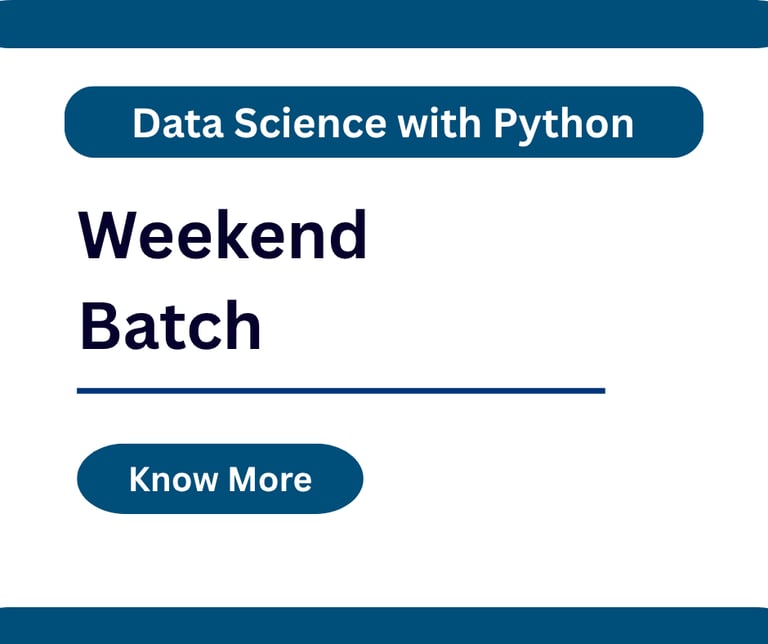

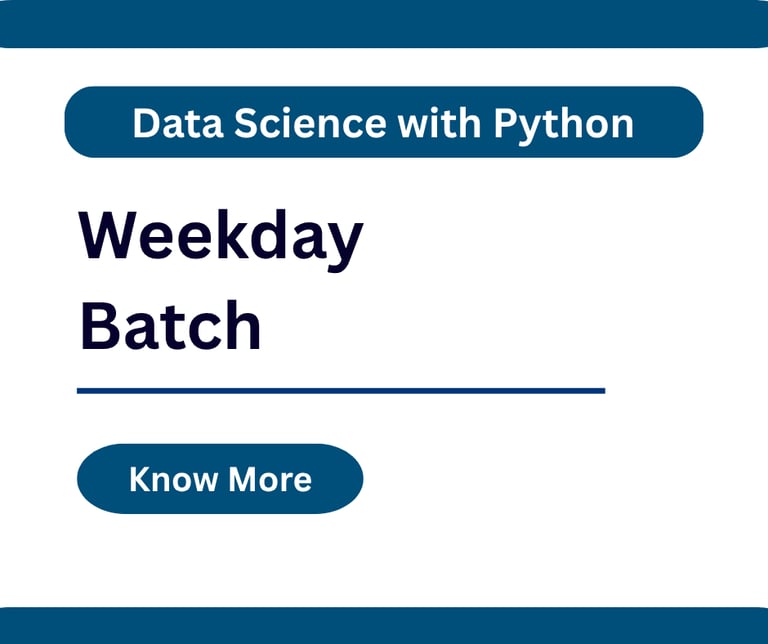

Our Mentors:
Ishika Das
Python Developer in Wipro
Asish Singh
Data Scientist in TCS
Ashna Singh
Data Analyst in IBM
Akshay Jain
AI/ML Engineer ex-Wipro
Our Mentors:
Shruti Aggarwal
Python Developer in Wipro
Ashish Singh
Data Scientist at TCS
Ashna Singh
Data Analyst in IBM
AI/ML Engineer ex-Wipro
Akshay Jain
Our Alumni Work at Top Companies
FAQs – Data Science with Python Certification Course at GIMIT
1. Who should attend this course?
Aspiring data scientists, data analysts, and machine learning engineers.
Professionals looking to transition into data science from fields like software development, business analysis, or statistics.
Individuals interested in acquiring hands-on skills in data analysis and machine learning using Python.
2. What will I learn in this course?
You will learn data manipulation, data visualization, machine learning algorithms, and model evaluation techniques using Python. You will also gain practical experience with tools like Pandas, NumPy, Scikit-learn, Matplotlib, and Seaborn, and work on real-world data science projects.
3. What are the prerequisites for this course?
Basic programming knowledge is helpful, especially in Python. A foundational understanding of mathematics, particularly statistics and linear algebra, will also be beneficial but not mandatory.
4. How long is the Data Science with Python Training?
The course typically lasts for 5-7 days, providing both theoretical knowledge and hands-on practice in data science.
5. Is the course available online?
Yes, this course is available in both in-person and live online formats, allowing flexibility for participants to attend from anywhere.
6. Will I receive any study materials?
Yes, participants will receive comprehensive course materials including slides, Python code examples, datasets, and additional resources for further learning.
7. How will this course benefit my career?
This course will equip you with the essential skills and tools required to start working as a data scientist or data analyst. You will gain hands-on experience in analyzing and modeling data, making you a valuable asset in any data-driven organization.
8. What is the Python-based machine learning framework that will be used?
The course will use Scikit-learn for machine learning algorithms, along with Pandas for data manipulation, NumPy for numerical computing, and Matplotlib and Seaborn for data visualization.
9. Will I receive a certificate after completing the course?
Yes, you will receive a certificate of completion from GIMIT Education Institute upon successfully finishing the course.
10. How can I register for the course?
You can register for the course through our website or by contacting our team directly. We offer both scheduled sessions and customized training for organizations.
11. Will I have hands-on experience during the course?
Yes, the course is designed to include practical exercises where you will implement machine learning models, analyze datasets, and solve real-world problems using Python.
12. What tools and libraries will I use in this course?
You will work with Python libraries such as Pandas, NumPy, Scikit-learn, Matplotlib, and Seaborn for data manipulation, machine learning, and visualization.

